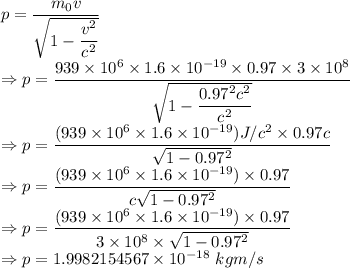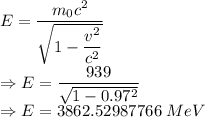
Physics, 12.02.2020 04:39 RaquelLWhite
A gold nucleus (with a radius of 6.5 fm in its rest system, containing 197 protons and neutrons of rest mass 939 MeV/c2 each) is accelerated to a speed of 0.97 c. Calculate (a) the momentum of an individual nucleon (ignoring binding energy effects). (b) the total energy of the gold nucleus, including its binding energy of 7.9 MeV per nucleon. (c) the diameter of the gold nucleus in the direction of motion as seen by an observer at rest.

Answers: 3


Another question on Physics

Physics, 22.06.2019 03:00
Dinate system, and a charge q = - 2.00 nc is placed s2 10 n> c. (a) what is the change in electric potential energy when the dipole moment of a molecule changes its orientation with respect to es from parallel to perpendicular? (b) at what absolute temperature t is the average translational kinetic energy 32 kt of a molecule equal to the change in potential energy calculated in part(: abovethistemperature,thermalagitationprevents the dipoles from aligning with the electric field.) placed in a uniform electric field e with magnitude 1.6 * 6 on the positive x-axis at x = 4.00 cm. (a) if a third charge q3 = +6.00 nc is now placed at the point x = 4.00 cm, y = 3.00 cm, find the x- and y-components of the total force exerted on this charge by the other two. (b) find the magnitude and direction of figure p21.62 ll uu 21.55 . torque on a dipole. an electric dipole with dipole moment ps is in a uniform external electric field es. (a) find the orientations of the dipole for which the torque on the dipole is zero. (b) which of the orientations in part (a) is stable, and which is unstable? (hint: consider a small rotation away from the equi- librium position and see what happens.) (c) show that for the stable orientation in part (b), the dipole’s own electric field tends to oppose the external field. 21.62 ..
Answers: 1

Physics, 22.06.2019 03:10
Aphysical change is a change in the size, shape,, or stafe of matter true or false
Answers: 1

Physics, 22.06.2019 11:00
Aperson walks first at a constant speed of 4.89 m/s along a straight line from point a to point b and then back along the line from b to a at a constant speed of 2.95 m/s. what is the average speed over the entire trip?
Answers: 1

Physics, 22.06.2019 19:40
It may seem strange that the selected velocity does not depend on either the mass or the charge of the particle. (for example, would the velocity of a neutral particle be selected by passage through this device? ) the explanation of this is that the mass and the charge control the resolution of the device--particles with the wrong velocity will be accelerated away from the straight line and will not pass through the exit slit. if the acceleration depends strongly on the velocity, then particles with just slightly wrong velocities will feel a substantial transverse acceleration and will not exit the selector. because the acc
Answers: 1
You know the right answer?
A gold nucleus (with a radius of 6.5 fm in its rest system, containing 197 protons and neutrons of r...
Questions

English, 26.10.2020 17:00



Mathematics, 26.10.2020 17:00


Computers and Technology, 26.10.2020 17:00


Computers and Technology, 26.10.2020 17:00





World Languages, 26.10.2020 17:00


Physics, 26.10.2020 17:00

Mathematics, 26.10.2020 17:00

Social Studies, 26.10.2020 17:00



Computers and Technology, 26.10.2020 17:00











